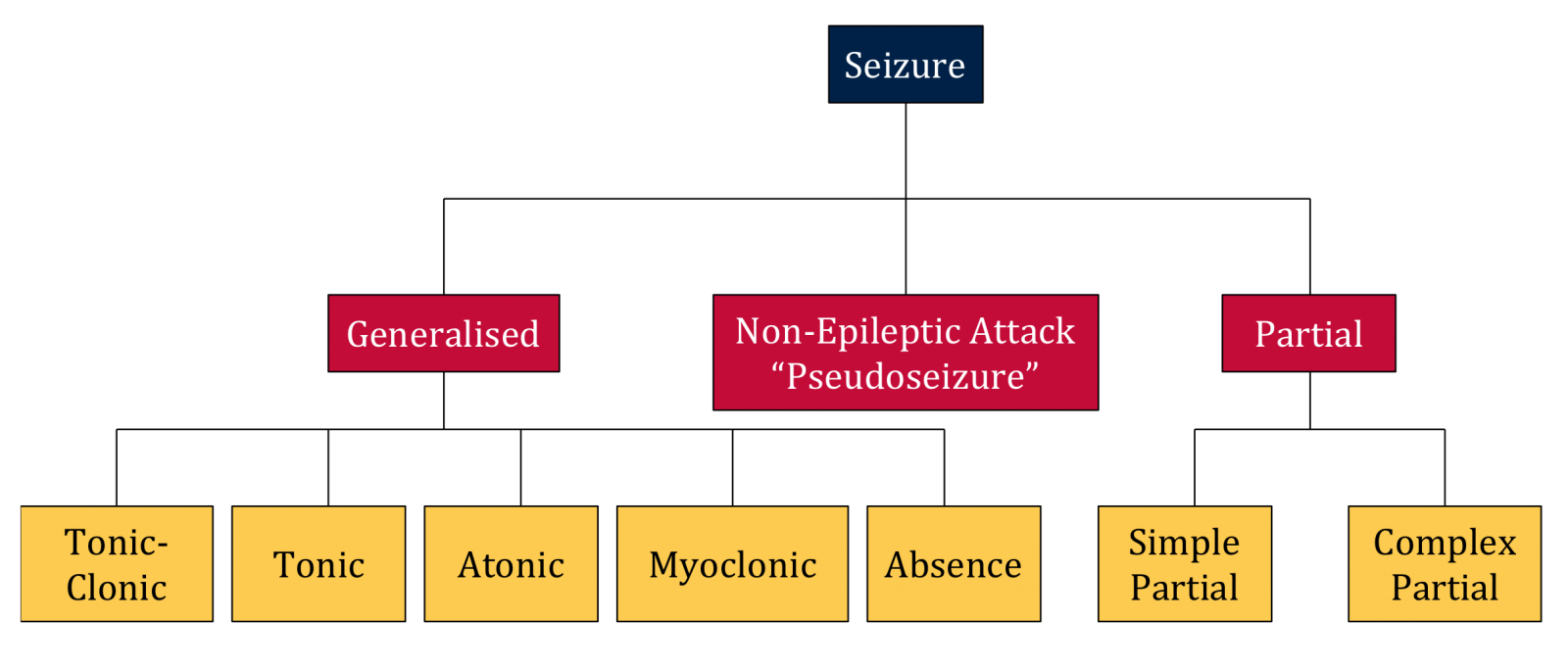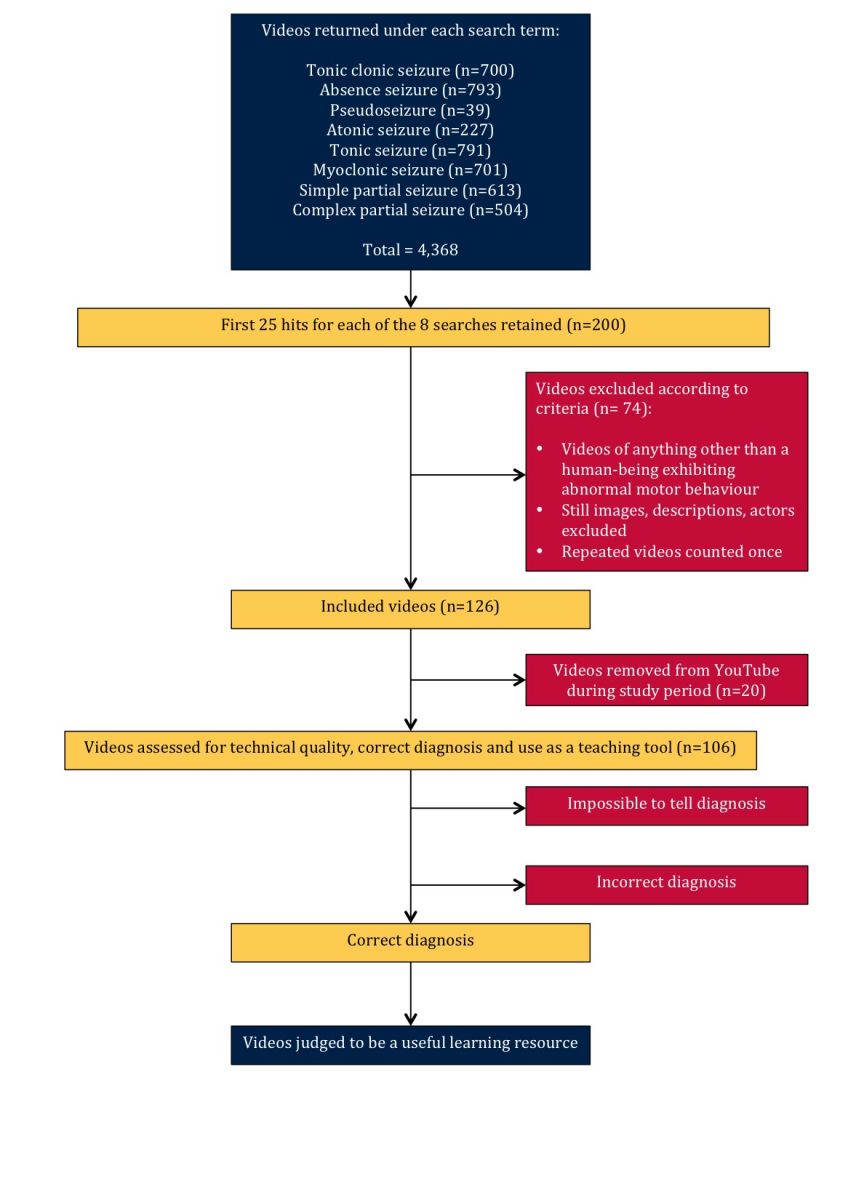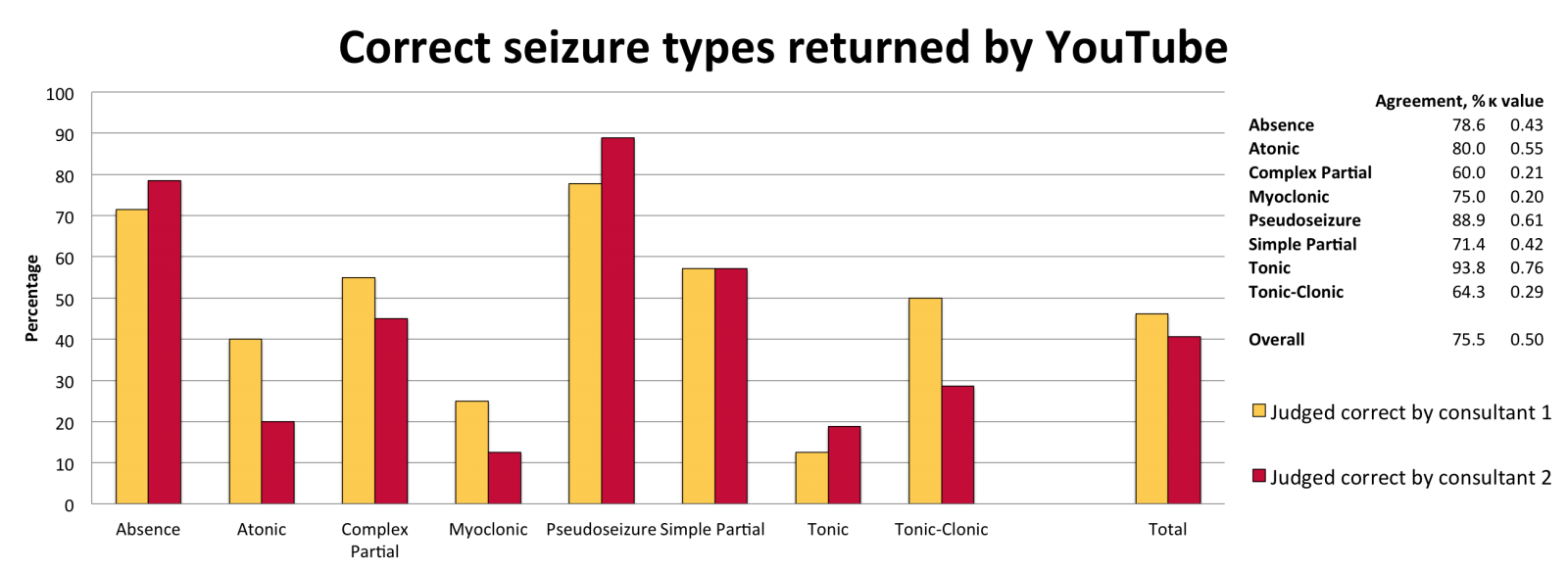


Authors
- Louwai Muhammed
- Jane Adcock
- Arjune Sen
Institutions
- University of Oxford - Oxford Epilepsy Research Group.
- NIHR Biomedical Research Centre - Oxford - United Kingdom
Epileptic seizures can be categorised into different subgroups largely by observing the behaviour of a patient during an attack (figure 1). YouTube contains hundreds of videos claiming to capture specific seizure events. This study assessed the accuracy of these videos and compiled a list of free and easily available seziure videos that can be used to teach students anywhere where there is access to YouTube.
 Figure 1: Categorisation of seizures (Modified from Ref. 1)
Figure 1: Categorisation of seizures (Modified from Ref. 1)
A YouTube search was performed for 8 different seizure types: Tonic-Clonic, Tonic, Atonic, Absence, Myoclonic, Simple Partial, Complex Partial, Pseudoseizure (Figure 2). The term “pseudoseizure” was searched instead of “non-epileptic attack” due to wider use by the general public.
The top 25 results for each search term were retained and inclusion and exclusion criteria were applied. Two consultant epileptologists then rated the remaining videos for diagnosis, technical quality and potential as a learning resource.
Videos judged to be useful as a learning resource were then compiled into a single video that demonstrated the characteristic features of each seizure subtype.
Five final year medical students at Oxford University were shown a different set of videos showing EEG confirmed seizures and were asked to diagnose each seizure subtype. They were then given a 45 minute teaching lecture using our YouTube video complilation and anonymously assessed on performance before and after the teaching.
 Figure 2: Stages of video analysis (Ref. 2)
Figure 2: Stages of video analysis (Ref. 2)
1) Engel, J. (2001). A Proposed Diagnostic Scheme for People with Epileptic Seizures and with Epilepsy: Report of the ILAE Task Force on Classification and Terminology. Epilepsia, 42(6), 796–803.
2) Muhammed, L., Adcock, J. E., & Sen, A. (2014). YouTube as a potential learning tool to help distinguish tonic–clonic seizures from nonepileptic attacks. Epilepsy & Behavior, 37, 221-226.
This work was supported by The National Institute of Health Research Oxford Biomedical Research Centre

63 % of the top 25 videos returned following YouTube searches depicted events that appeared to show some form of epileptic or non-epileptic attack.
Fewer than 50 % of videos meeting inclusion criteria were deemed to show the correct seizure type (31.1 % were deemed correct by both consultants).

Only 38.7 % of these videos were deemed potentially useful teaching tools by at least one consultant (14.1 % were deemed useful by both).

The percentage of videos correctly recognised as epileptic vs non-epileptic by the students improved from 62 % before to 82 % after teaching (p=0.00147, 50 data points). The percentage of videos correctly diagnoses improved from 56 % before to 70 % after teaching (p=0.0167, 50 data points). The average confidence students felt in recognising epileptic from non-epileptic seizures increased from 53.4 % before to 75.8 % after teaching (P<0.001, 50 data points). The average confidence students felt in their diagnosis increased from 47.2 % before to 72.5 % after teaching (P<0.001, 50 data points).
The students also provided excellent feedback on the session:
1) How useful did you find this session?
Excellent (5/5) = 100%
2) Did you find learning though videos was more helpful than reading text based descriptions alone?
100% yes
3) Would you like to have more teaching in this format?
100% yes
4) Would you recommend this session to another medical student?
100% yes
The complete compilation video used in this study can be viewed below:
The URLs of the videos rated as useful for teaching are listed below:
Absence: https://www.youtube.com/watch?v=H3iLQi6wt94
Atonic: https://www.youtube.com/watch?v=9obFVWW47NE
Complex Partial: http://www.youtube.com/watch?v=zy4q2SNsEDI
Non-Epileptic Attack: http://www.youtube.com/watch?v=ohroNLBZIOU
Simple Partial: http://www.youtube.com/watch?v=JN97v44OF9c
Tonic: http://www.youtube.com/watch?v=jfj-V5rhKQI
Tonic Clonic: http://www.youtube.com/watch?v=Nds2U4CzvC4
Myoclonic: https://www.youtube.com/watch?v=SPWZVa5X5T8
The majority of videos on YouTube claiming to show specific seizure subtypes are inaccurate. However, a small group of videos show clear examples that could be used by an expert teacher to demonstrate specific seizure types for students. We have compiled these videos into a free and easily available resource that can be accessed by educators anywhere that YouTube is available.

